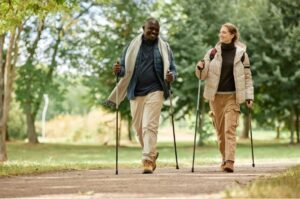Whether you’re going on a hiking trip, walking on cobblestone streets, or just need a little help with balance, trekking poles (aka hiking poles or walking poles) can become a great friend on your travel journeys. The trick is how to bring your trekking poles on the plane.
Trekking poles started making their way into my travel kit when I broke my femur a few years ago. I don’t always take them, but I sometimes do if I think we’ll be walking on rocky or hilly terrain, over lots of cobblestones, or uneven pavement. I find them incredibly useful.
In this post, you'll learn about trekking poles, their benefits, which features to look for if you're purchasing new ones, and how to pack trekking poles for a flight.
What Are Trekking Poles
 Trekking poles are poles like you see here. Some have telescoping sections you can adjust to different lengths, or there are collapsible poles that fold. This way, you can fit them in your luggage during air travel and adjust them for your height and terrain when using them.
Trekking poles are poles like you see here. Some have telescoping sections you can adjust to different lengths, or there are collapsible poles that fold. This way, you can fit them in your luggage during air travel and adjust them for your height and terrain when using them.
They have comfortable grips and straps, so they’re easy to hold while walking, or they can dangle from your wrist if you need to grip something else for a moment.
They’re very lightweight, commonly made from aluminum or carbon fiber, and many come with different tips for different conditions.
Why Use Trekking Poles
Trekking poles offer several benefits, especially to those of us over 50.
Improved balance
Maintaining balance can become more challenging as we age. Trekking poles are great because they act like outriggers and provide extra points of contact with the ground. They are especially helpful in reducing the risk of falls if you're navigating trails with roots or loose rocks or trying to stay upright on ancient cobblestone streets.
Reduced strain on joints
Trekking poles distribute the impact of your steps across both your upper body and your legs. This helps to reduce shock with each step, which means less stress on your knees and ankles.
According to several studies, using a trekking pole could reduce force on your knees and ankles by as much as 25%. That means greater comfort and less wear and tear on your joints.
Increased calorie burn
 Now we’re talking! Walking with trekking poles won’t use sufficient calories for that second serving of Italian pasta. But a study in the Journal of Strength and Conditioning Research says that “trekking poles may be a beneficial tool for increasing caloric expenditure, as energy production increased during exercise without increased perceptions of effort.
Now we’re talking! Walking with trekking poles won’t use sufficient calories for that second serving of Italian pasta. But a study in the Journal of Strength and Conditioning Research says that “trekking poles may be a beneficial tool for increasing caloric expenditure, as energy production increased during exercise without increased perceptions of effort.
Even though you may only be burning a few calories more, you’ll find that walking with trekking poles helps you get into a rhythm so you can walk more easily for longer.
More confidence
If you haven’t used trekking poles before, you’ll be surprised at the confidence you’ll build once you get used to them.
Breaking my femur (while hiking without trekking poles) made me a little leery of hiking. While my brain knew it was a one-time occurrence, my body wasn’t so sure, and I was hesitant at times. However, armed with my trusty trekking poles, I started feeling more secure, whether on the trail or negotiating the deep holes in the sidewalks of Asia.
New experiences
With more confidence, you’ll feel comfortable going to different places. Cobblestone streets? No problem. Steep descents? Your knees won’t complain. Big hills? Your arms pull you right up.
Overall, trekking poles make activities more accessible and enjoyable for people over 50. They allow you to explore further with more confidence and potentially fewer aches and pains.
Expert advice
Have arthritis? Trekking poles will be a big help if your arthritis is in your lower extremities.
However, if you have arthritis in your hands, as I do, it’s important to know how to use the wrist straps properly. This way, you don’t have to grip the poles tightly with your hands. Watch this video to learn how.
Another tip I’ve found useful is to wear a pair of bicycle gloves which provide extra padding.
The Best Trekking Poles to Bring on the Plane
The best walking poles to bring on the plane are:
Lightweight
Aluminum or carbon steel are the best.
Collapsible
Look for telescoping poles that come apart in 3 pieces or collapsible hiking poles that fold into 3 parts. This makes them easy to pack in your luggage, something you can't do with a large walking stick. You also want to be able to fold them up if you’re on a bus or train or in a restaurant, so there's no chance of someone else tripping.
Fit in your luggage
If you're buying new poles, take the bag you want to pack them in when you go shopping so you know they'll fit.
Fit your height
 When holding the pole to walk, your arms should be at a comfortable 90-degree angle. This is true whether you’re taking them on the plane or just using them around your home.
When holding the pole to walk, your arms should be at a comfortable 90-degree angle. This is true whether you’re taking them on the plane or just using them around your home.
If you’re purchasing new poles for an upcoming trip, buy them from a retail outlet rather than online, if possible. This way, a knowledgeable salesperson can help you find the right fit.
Easily adjustable
You’ll need to extend and collapse them when taking them in and out of your bag, and you’ll want to adjust the length when going uphill or downhill vs. on flat ground. So you want poles that you can adjust easily.
Clean
Clean off any accumulated dirt and grime before you take them on your trip.
Adaptable to different conditions
Consider getting removable rubber caps that are easy to put on and take off. Placing rubber caps on the end of your poles will help keep the sharp tips of the metal tips from poking holes in your luggage and possibly injuring baggage handlers.
They’re also great for walking on pavement or indoors. You'll want them off if you’re hiking, and a TSA agent made me remove them during security screening, so you want them easy to take off and put back on.
If you're only using your poles for walking on pavement, packing bubble wrap around the tips is a good option instead of taking rubber tips you won't need.
Can You Bring Your Trekking Poles on the Plane
The answer is probably yes, but there are no guarantees. It depends, upon other things, on your airline, your destination, and the person working at the security checkpoint that day.
How to Bring Your Trekking Poles on the Plane
Keep the following in mind when deciding whether to bring your trekking poles on the plane.
Where to pack them
TSA guidelines say that trekking poles are not allowed in carry-on bags and must be in your checked bag. However, the final decision rests with the TSA officer as to what can make it through the security checkpoint, so it’s a very gray area.
When I was healing from my broken leg, I took a wheelchair to the gate and passed through security screening with my hiking poles extended without a problem. In that case, they determined I needed them due to my mobility issues. I booked a window seat, then folded them up and laid them alongside the plane so they were out of the way of anyone’s feet in case of emergency.
I’ve also broken them down and taken them in my carry-on luggage, no questions asked. If you do want to try taking them in your carry-on, you should pack them so that you can easily retrieve them if the officer at the TSA checkpoint wants to inspect them to be sure they’re not concealing any prohibited items.
If you want to take them as carry-on items, check with the airlines you’ll be traveling on to be sure your bag will fit in the overhead bin, as this can be a problem on smaller planes. In addition, different airports and international airlines may have different rules regarding hiking poles.
Good quality, lightweight trekking poles are not cheap! So, if you're concerned about having to abandon them in airport security or customs, you have several options.
You can pack them in your checked baggage or buy an inexpensive pair when you arrive. You can rent a quality pair when you arrive at your destination or ship them ahead of time. And if you're traveling internationally, depending on the exchange rate, you may even be able to buy a quality set for less than you’d pay in the U.S.
Your airline’s regulations
Different airlines have different policies. It depends on whether the airline classifies hiking or trekking poles as sports equipment, potential weapons, or assistive devices needed for medical reasons. Some airlines may require a doctor’s note.
And keep in mind that a small, regional airport might allow your hiking sticks in your carry-on for short domestic flights, but if you transfer to a plane in another city, that airline might not allow them. So you'll need to check with each airline you'll be traveling on.
Packing your trekking poles in your checked luggage is safest unless you want to gamble with losing them.
International regulations
Different countries have different regulations, not only regarding what you can fly with and where it needs to be packed but also what you’re allowed to bring into the country.
For example, Canada says trekking or hiking poles are only allowed in checked luggage but may be allowed as a mobility aid, like a walking cane. Likewise, the United Kingdom only allows walking sticks and trekking poles in checked luggage but may classify them as a mobility aid, which means you can bring them on.
The European Union and Australia aren’t clear either, while New Zealand specifically states you can carry on aluminum or carbon-fiber poles that fit in the overhead locker, while hiking poles made of a heavier material must be in checked luggage.
Canada, New Zealand, and other countries also have regulations about the cleanliness of poles. So you must have them inspected when you enter the country to ensure they’re free of pests, diseases, and seeds.
Conclusion
Trekking poles can be invaluable travel buddies. They offer stability to protect against falls, reduced stress on your joints, and even an extra calorie burn (although not enough to compensate for that dessert you've been eyeballing 🍰).
Whether you're navigating cobblestone streets or on an adventurous hike, these lightweight poles provide confidence and accessibility, particularly for those of us over 50.
When it comes to air travel, in most cases, it's safest to stow them in your checked luggage to ensure compliance with airline regulations. You don't want to have to leave your expensive poles at the airport while you travel on without them!
Remember to clean your poles before you leave for the plane and check international regulations to prevent them from being confiscated when you arrive because they're deemed a biohazard.
So, pack wisely if you want to bring your trekking poles on the plane.
Here's to smooth and adventurous journeys ahead! Good luck and safe travels. 👋✈️
👉 Want more travel tips? Sign up for our Coffee & Compass newsletter for tips on traveling smartly in the second half of life.
Here are some other posts that might be of help to you in your journeys:
Easy Tips to Get Through Airport Security Faster
- About the Author
- Latest Posts
Peggy is a retired entrepreneur and world traveler, now happily traveling in the second half of life. She’s flown over 2 million miles and spent time in 48 states and 50+ countries, much of this since she turned 50. Read the About page to learn more about Peggy and why she started The Smart Travel Guide 10 years after retiring. If you want to send Peggy a brief message, visit her contact page.

So many good tips! Before I signed up you guys sent me links to a couple free guides – one on packing, one on prepping my house before I leave. I travel a lot but you included things I didn’t think of!
Glad they were helpful, Monica!
What do you think is more important as I consider buying poles, the weight and construction of the poles or how comfortable they seem to be in the store? I’m not a pro trekker so I’m not sure what’s most important.
It depends on your height, your budget, and whether you’re climbing the Pyrenees or just needing a little stability. I suggest you visit REI or EMS or another outdoor store and chat with someone who can explain the different poles to you and be sure you’re choosing ones that fit properly. Take plenty of time to walk around the store with them to make sure they’re the right ones for you.
Great article! The only comment I would make is absolutely use your rubber tips while you’re walking, especially in the city. The steel tips are not useful on hard surfaces and the clicking sound can be extremely irritating.
Thanks, Linda. Yes! That’s a great idea.